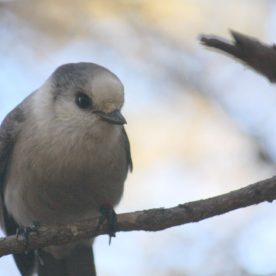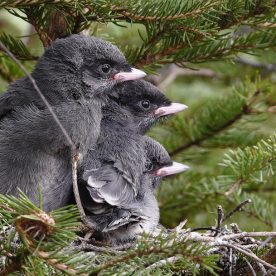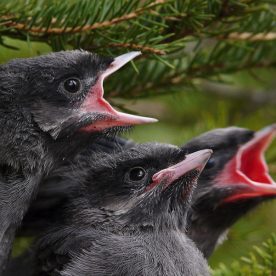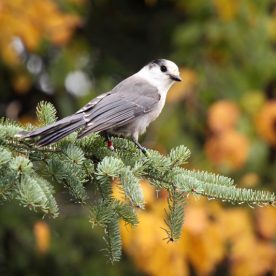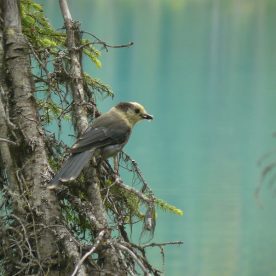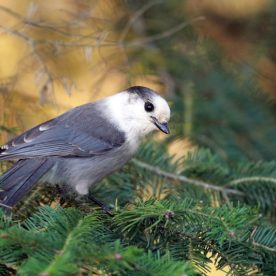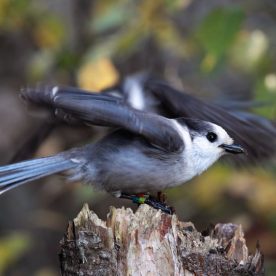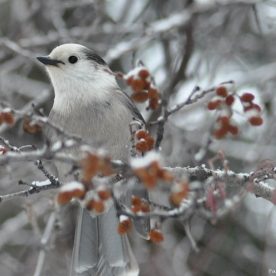Description
The Gray Jay Perisoreus canadensis is only slightly smaller than a Blue Jay and, silhouetted against the sky, the two birds are surprisingly similar, although the Gray Jay is a somewhat slower and weaker flier than its southern relative. Close up, the Gray Jay can hardly be confused with any other bird. Its back and tail are a medium gray and the underparts a slightly lighter shade, but the head has a quite striking and unique pattern of black and white. The short, black bill, the large dark eyes, and the thick, fluffy plumage, help give the Gray Jay a soft, rounded appearance that most people find highly appealing. For the Gray Jay, of course, the thick plumage is what keeps it warm on long winter nights or in cold snaps when the temperature may be 40 below zero for days at a time.
Juvenile Gray Jays just out of the nest are very different from the adults, being a uniform, sooty gray colour all over their bodies. Young and old are so distinct, in fact, that they were at first thought to be different species. Juveniles begin their first moult in July, however, and by the end of August they essentially look just like the adults.
Habitat and Habits
Song
The Gray Jay is notably quieter than many members of the crow and jay family but it still has a rich vocal repertoire. Members of a pair or family group moving through the forest frequently give single, quiet twirks or whuits. These are probably ‘contact notes’ by which each bird in the group keeps track of the others’ whereabouts. A harsh chatter is associated with the mobbing of terrestrial predators and soft repeated whistles, hoo, hoo, hoo are given when aerial predators are spotted. Among several vocalizations reserved for social interactions, there is a beautiful ‘whisper song’, a long jumble of soft melodious notes interspersed with quiet clicks. It is given by birds of either sex and may help members of a mated pair to synchronize their sexual cycles. Gray Jays can give excellent, though usually very quiet, imitations of predators (especially hawks and crows). No-one knows if a jay mimicking a predator is communicating the predator’s identity to its mate or merely that some general danger is present.
Young Jays
When young Gray Jays leave the nest at 23 days of age they are well feathered (though short-tailed) and they can fly quite well. For their first two weeks out of the nest, however, they spend most of the time sleeping in thickly foliaged conifers, often huddled together on the same branch. When they hear their parents approaching, they spring to life and, with flapping wings, gaping red mouths, and sustained squalling notes, they vie with each other for some of the incoming food. Bouts of feeding are followed by exercise and perch changes, and sometimes by a series of short flights totalling 100 metres or so through the forest.
By the time the young are 44 days old (21 days out of the nest), they are truly skilful fliers and their tails are full-grown. They then almost always accompany the adults through the forest. Although they relentlessly beg for food, at this point they start to pick up food by themselves—and even to store it. The parents then feed them less and less and, by the age of 50 days, the young are nutritionally independent. This sets the stage for a radical new development in the fledglings’ lives. Between the ages of 55 and 65 days, the young increasingly fight among themselves and one eventually succeeds in expelling its former nest-mates from the natal territory. Henceforth the dominant juvenile (a male in two thirds of cases) will accompany its parents alone through the summer, fall and winter of its first year. As for the ejected birds (the majority of which are females), they quickly leave and a few succeed in attaching themselves to unrelated pairs, particularly those that have failed in their own nesting that year. Most ejected juveniles aren’t so lucky, however. Eighty percent of them are dead by their first autumn, as opposed to only 50 percent of the dominant juveniles that get to stay with their parents and benefit from their example and protection.
The nonbreeding Gray Jays that survive stay on their natal or adoptive territories and use them as a safe base from which to search the surrounding country for a newly opened vacancy in the neighbourhood breeding population. When they find one, they quickly move in and replace the former breeder. Members of a mated pair stay on the same territory for the rest of their lives. When one of the pair dies, it too is quickly replaced by another bird from the local nonbreeding population.
Range
In Canada the Gray Jay is found from coast to coast, in all thirteen provinces and territories, and from the tree line in the far north, south to the last isolated spruce bogs at the edge of farm country not far from—though never in—many of our towns and cities. In the United States it is a common north-woods bird in Alaska and again in the western mountains, all the way down to New Mexico and Arizona.
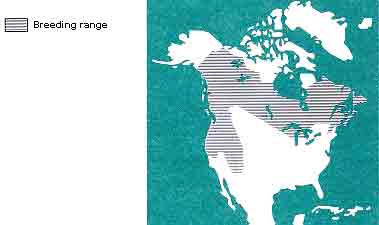
Remarkably, wherever it occurs, even in the extreme north or close to the tree line in the highest mountains, the Gray Jay is a permanent resident. All year long, mated pairs occupy territories of about 65 to 70 hectares, often sharing them with an extra, nonbreeding jay that is usually one of their young from their previous nesting. Territory-holding adults do not migrate, even for short distances, and the rare fall movements sometimes reported from south of the breeding range probably involve young birds that have not yet acquired a territory of their own.
Because almost all Gray Jays stay in one place and do not have to face the perils of long annual migrations, they often live a very long time for such a small bird. Territory-owning individuals have an average lifespan of about 8 years and some jays reach the age of 15 or 16 years. Even more remarkable, of the few deaths that occur every year among territory-owning Gray Jays, most happen in summer (probably because of migratory hawks like Merlins and Sharp-shinned Hawks). As puzzling as it may be, long northern winters are apparently no problem for the Gray Jay!
Feeding
The seeds of coniferous trees are a major and obvious food in the boreal forest but Gray Jays do not eat them. This leaves six other sources of energy that might fuel their year-round occupancy of permanent territories and annual production of young. Those foods are insects and spiders, berries, the occasional small mammal or amphibian, carrion, bird eggs and nestlings, and fungi. Gray Jays eat all of these foods, finding them by slowly moving through the forest as a pair or family group, pausing frequently on mid-level perches to scrutinize the forest floor and surrounding trees. Very little escapes their sharp eyes and they usually find any new food on their territories (such as dead animals) within a few hours at most. They are also ready to capitalize on any sudden opportunity that may present itself. They will snap up flying insects just like a flycatcher, quickly pounce on a mouse or shrew that ventures out into the open, and rapidly learn that human beings provide a wide variety of strange but nourishing foods.
The secret of the Gray Jay’s success is food storage. Any food beyond a jay’s immediate needs is worked back and forth in the bird’s mouth so that the morsel becomes covered with sticky saliva from its greatly enlarged salivary glands. Thus prepared, the food is stuck behind a piece of bark, under some lichen, or in almost any other conceivable nook or cranny somewhere up in the trees. During long summer days near the Arctic Circle, a food-storing Gray Jay may make up to 1000 caches a day. It thus accumulates, over the short season of plenty, the food stores that it will need for the following 7 or 8 months of otherwise foodless winter.
Gray Jays guard against theft by covering up their food stores with a piece of bark or lichen and they place them as evenly as possible throughout the forest. They do not pack them into single hiding places like hollow trees or even put them close together in the same general area. Spreading out the food caches prevents disastrous losses of large amounts of food to other Gray Jays or different animals that might happen to find a given hiding place. It also discourages competitors from looking for more food that might be hidden nearby. Astonishingly, it seems that Gray Jays actually remember where they have hidden their food and this is how they recover it and survive the winter without migrating. No human could ever accomplish such a feat but several lines of evidence suggest that Gray Jays do exactly that.
Breeding
Gray Jays nest extraordinarily early in the year. Nest-building may start in February when there is a metre of snow on the ground. In the southern part of Gray Jay range eggs are laid on average around March 21st; they hatch around April 10th; and the young leave the nest around May 1st—well before most migratory birds have even returned to the boreal forest, let alone begun to nest themselves. The sight of a female Gray Jay snuggled down on her eggs in 30 below weather, or of jay parents feeding nestlings in the middle of a raging blizzard is among the most amazing spectacles of nature.
Several things make early nesting possible. Gray Jay nests are large and well insulated thanks, in part, to hundreds of cocoons that fill in the interstices of the bulky platform of dry dead twigs. Close to the centre are finer twigs, strips of bark, arboreal lichens, and finally, lining the cup itself, several hundred grouse feathers or an equivalent amount of hair or fur. The cup is just large enough to contain the eggs (2 to 5, but most often 3), and the body of the female. Whether it is built close to the trunk of a spruce or fir (the usual situation) or out on a long branch, the nest is almost always on the south side of the tree, within one metre of the outside tips of the tree’s foliage, and very often on the north side of a clearing, creek-edge, or some similar break in the forest. This means the nest and the incubating female receive a little more direct sunlight than might otherwise be the case.
Unlike most other birds, a female Gray Jay sits on her nest beginning with the first egg, apparently to keep it from freezing. True incubation starts when the last egg is laid and, 18 days later, all the eggs hatch within a few hours of each other. At first, the male brings all the food for the nestlings. They hatch out as tiny pink babies, their backs thinly covered by gray, wispy down. The female broods over them for the next week or so, after which they are big and well-feathered enough that she can start accompanying the male on his foraging trips. The parents gather food until their bulging throats can hold no more and then they silently glide to the nest to feed the young. By maximizing their food loads, the adults keep their flights to the nest down to an absolute minimum (about once an hour). This helps keep the nest location a secret from Red Squirrels, a common and dangerous nest predator in Gray Jay country. For the same reason, the adults prevent any nonbreeding Gray Jay on their territory (such as one of their young from the year before) from ever going to the nest. Nonbreeders are thus prevented from helping to feed the young—although they are allowed to do so after the young leave the nest. (Red Squirrels are not a significant threat to flying young so it doesn’t matter after nest-leaving time if the young receive many noisy feeding visits from adults and nonbreeders). The young can normally fly by the time they are 21 days old but they usually stay in the nest for another two or three days. Late departure probably lessens the chances of a crash landing on melting snow or, worse, in the icy meltwater that often floods spruce bogs in late April.
The most important thing that Gray Jays do in order to succeed in their late winter nesting is to store food the previous summer and fall. Although some insect life becomes available on warm, sunny days in the April nestling period, there can be no doubt that previously stored food provides, at the very least, a sort of “bad weather insurance”. This allows Gray Jay parents to undertake the huge, energy-demanding task of reproduction at a time of year when the forest contains almost no obvious food supply. But explaining how Gray Jays get away with nesting so early is not nearly as important as explaining why they do it. Why don’t Gray Jays nest in May and June the way other boreal forest birds do? Wouldn’t they produce more surviving babies if they timed their nesting to coincide with the annual peak in insect abundance?
The answers to these questions may lie with the fact that early-nesting Gray Jays can invest more food storage effort in their territories than hypothetical late-nesting pairs. Accumulating the largest possible food stores may be crucial in allowing Gray Jays to have enough stored energy to last all winter. This means they can stay at home and avoid having to migrate and to expose themselves to the terrible dangers of travelling long distances through unfamiliar country. Thus, even if early-nesting Gray Jays cannot produce as many young per year as they would by nesting in warmer weather, they probably still produce more young over their entire lifetimes. This is simply because they live longer and get to breed more times than if they nested late (but also had to migrate and therefore died, on average, at a younger age). Seen in this light, it is only partly true that food storage is what allows early nesting to succeed. It may be even truer to say that early nesting is what allows food storage to succeed!
Conservation
Gray Jays occupy a truly enormous range in North America. With rare exceptions the boreal and sub-alpine forests they occupy will never be converted to agricultural or urban landscapes so vast stretches of their habitat seem secure for the foreseeable future. True, forest fires and logging make some areas unsuitable for jays every year but such disturbances are temporary. Within a few decades, the affected areas are reoccupied by new forests and new Gray Jays. Similarly, Gray Jays are highly vulnerable to traps set for fur-bearing mammals, but the density of traps is low and very few jays ever see a trap, let alone get caught by one.
The one way that humans may pose a real threat to Gray Jays in the coming years is by increasing the level of carbon dioxide and other greenhouse gases in our atmosphere. The resultant global warming can be expected to cause the ranges of many plants and animals to shift northwards and this may be particularly true for the Gray Jay. As we have seen, its formula for success is “to store food and stay at home”. If the food storage part of this strategy consists of “putting the food in a big outdoor fridge” then the last thing a Gray Jay needs is fridge failure. Regrettably, evidence is accumulating from at least one location at the south edge of the Gray Jay’s range that Gray Jays are declining in a way consistent with the idea of food stores being spoiled by rising temperatures. Ontario’s Algonquin Park is the location for the longest field study ever undertaken of the Gray Jay and the evidence is clear. From 1980 to 2005, the number of territories occupied by Gray Jays slowly fell by over 60 percent. At the same time, there was a downward trend in the average nesting success of Algonquin Gray Jays and a strong association of warmer than average falls with poorer than average production of young in the following breeding seasons. It will be sad indeed if this beautiful and fascinating bird of the boreal forest is forced by global warming to dwindle away completely in the southern part of its range.
Resources
Online resources
Printed resources
Campbell, R. W. et al. 1997. The birds of British Columbia. Vol. 3. Passerines. Canadian Wildlife Service, Ottawa, and British Columbia Wildlife Branch, Vancouver. Pp. 188-193.
Godfrey, W.E. 1986. The birds of Canada. Revised edition. National Museums of Canada. Ottawa.
Strickland, D. 1991. Juvenile dispersal in Gray Jays: dominant brood member expels siblings from natal territory. Can. J. Zool. 69: 2935-2945.
Strickland, D. 1996. Gray Jay. Pages 718-721 in The breeding birds of Quebec: Atlas of the breeding birds of southern Quebec. J. Gauthier and Y. Aubry, eds. Association québécoise des groupes d’ornithologues, Province of quebec for the Protection of Birds, and Canadian Wildlife Service.
Strickland, D. and H. Ouellet. 1993. Gray Jay. In The birds of North America, No. 40. A. Poole, P. Stettenheim, and F. Gill, eds. The American Ornithologists’ Union, Washington, D.C., and The Academy of Natural Sciences, Philadelphia, Penn.
Strickland, D. and T. A. Waite. 2001. Does initial suppression of allofeeding in small jays help to conceal their nests? Can. J. Zool. (in press).
Waite, T. A. and D. Strickland. 2006. Climate change and the demographic demise of a hoarding bird living on the edge. Proc. R. Soc. B.



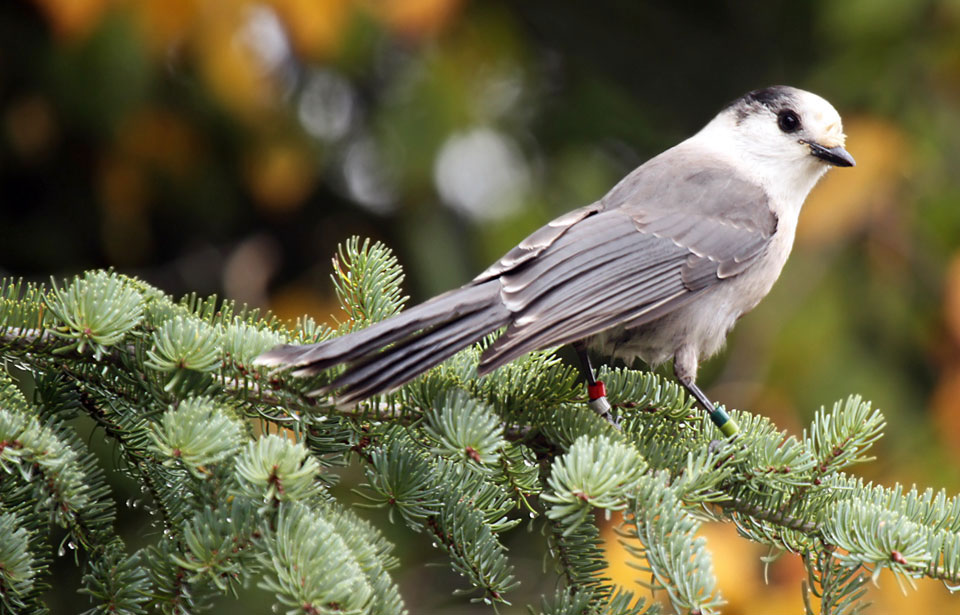
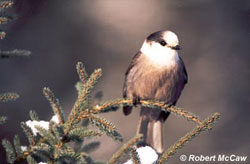 The Gray Jay is indelibly associated with Canada’s great northern forests.
The Gray Jay is indelibly associated with Canada’s great northern forests.